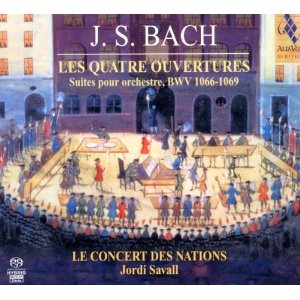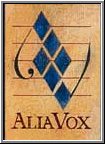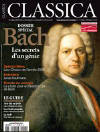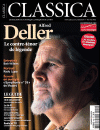|
Johann
Sebastian Bach
(1685-1750)
Les quatre ouvertures - Suites pour
orchestre BWV 1066-1069
Orchestral Suites, BWV 1066-1069 |
|
|
|
Alia Vox AVSA9890
Code-barres/Barcode:
7619986398907 |
|
Édition remasterisée |
Remastered edition |
|
Super Audio CD |
|
|

|
Description:
Quatre ouvertures,
(Suites pour orchestre),
BWV 1066-69)
Artistes / Performers
Le Concert des Nations,
Direction: Jordi Savall
Lieu d'enregistrement / Recording site:
Grande Salle de l'Arsenal à Metz
(France)
Date d'enregistrement: Août
1990
Recording date: Août
1990
Durée totale / Total time: 105'00
|
 |
 |
|
Édition
originale/Original recording
Astrée - 8727/8 |
Réédition-Reissued
Naïve - 9958 |

|
|
|
 |
|
 Cet enregistrement
des "Suites pour orchestre" a été réalisé en combinant les
forces de deux des ensembles que dirige Jordi Savall, soit le Concert
des Nations et La Capella Reial de Catalunya. Cet enregistrement
des "Suites pour orchestre" a été réalisé en combinant les
forces de deux des ensembles que dirige Jordi Savall, soit le Concert
des Nations et La Capella Reial de Catalunya.
Savall obtient ainsi un orchestre composé de 24 instruments
dits d'époque.
Notons la participation à cet enregistrement de Fabio Biondi
(violon) et de Marc Hantaï (flûte). Sont également de la partie
des complices de la première heure, tels Jean-Pierre Canihac
(trompettes), Pedro Estevan (percussion), Paolo Pandolfo
(contrebasse), Lorenz Duftschmid (violone) et Pierre Hantaï (clavecin).
 This recording of the "Orchestral
Suites" was made with the combined efforts of the two ensembles led
by Jordi Savall, that is the Concer des Nations and La Capella Reial
de Catalunya.
This recording of the "Orchestral
Suites" was made with the combined efforts of the two ensembles led
by Jordi Savall, that is the Concer des Nations and La Capella Reial
de Catalunya.
Savall thus obtains an orchestra made up of 24 musicians with period
instruments. It is worth mentioning the participation of Fabio
Biondi (violin) and Marc Hantaï (flute). We also find some early
collaborateurs of Savall, such as Pierre Canihac (trumpets), Pedro
Estevan (percussion), Paolo Pandolfo (double bass), Lorenz
Duftschmid (violone) and Pierre Hantaï (harsichord).
|
|
Évaluations recensées / Reviews
located |
|

06/1991
|

#
369
- (03/ 1991) |

#
118 (12-2009/01-2010) |
|

36:2 (11-12/2012) |

Matthias Lange
|

Full text / texte intégral
Review by:
Anastasia Tsioulcas |

(See below)
|

Jean-Jacques Millo
  
|
LES
ENCHANTEMENTS BAROQUES
Monique Parmentier |
|

Suites pour orchestre (BWV 1066-1069) |

Orchestral Suites (BWV 1066-1069) |
|

Extrait du livret / From the liner notes |
|
 Après une Ouverture à la française, la
Suite no. 1 propose une Courante, deux Gavottes, la deuxième
faisant appel aux cordes à l’unisson, comme motif principal
entendu à la basse, un unique comme pour suggérer un effet de
fanfares en l’absence de trompettes. Suit une Forlane, danse
originaire du Frioul et reprise en France, seule à apparaître dans
les quatre Suites. Puis deux Menuets, deux Bourrées et deux
Passepieds, trois danses également françaises. Les quatre couples
de danses sont indiquées «alternativement», c’est-à-dire que la
première est chaque fois reprise après l’exécution de la deuxième,
ainsi que procèdera plus tard le troisième mouvement de la
symphonie classique. On notera les jeux d’opposition du tutti avec
le concertino constitué par les deux hautbois et le basson, là
encore dans l’esprit de la suite française.
Après une Ouverture à la française, la
Suite no. 1 propose une Courante, deux Gavottes, la deuxième
faisant appel aux cordes à l’unisson, comme motif principal
entendu à la basse, un unique comme pour suggérer un effet de
fanfares en l’absence de trompettes. Suit une Forlane, danse
originaire du Frioul et reprise en France, seule à apparaître dans
les quatre Suites. Puis deux Menuets, deux Bourrées et deux
Passepieds, trois danses également françaises. Les quatre couples
de danses sont indiquées «alternativement», c’est-à-dire que la
première est chaque fois reprise après l’exécution de la deuxième,
ainsi que procèdera plus tard le troisième mouvement de la
symphonie classique. On notera les jeux d’opposition du tutti avec
le concertino constitué par les deux hautbois et le basson, là
encore dans l’esprit de la suite française.
L’ordonnance générale de la Suite n° 2 est
sans doute la plus originale des quatre. Après l’Ouverture
se succèdent en effet un Rondeau en rythme de gavotte, une
Sarabande, deux Bourrées, la deuxième «doucement» avant la
reprise «alternativement» de la première, une Polonaise avec
son Double dans lequel la flûte varie le Menuet et, pour
conclure, une Badinerie virtuose et gracieuse, hommage
obligé à la France et à sa légendaire légèreté.
Après la grandiose Ouverture de la Suite
n° 3, le très célèbre Air, aux cordes seules, fait entendre
l’une des plus suaves mélodies sorties de la plume de Bach,
l’une de ses pages les plus justement populaires. Se
succèdent ensuite deux Gavottes (avec reprise de la
première), une Bourrée et une Gigue.
Enfin, dans la Suite n°4, on observera
comment le compositeur isole le petit choeur des quatre bois
(trois hautbois et basson) pour l’opposer aux cordes en
effets de polychoralité (fugato rapide de l’Ouverture,
Bourrées, Gavotte). Après l’Ouverture se suivent en effet
deux Bourrées («alternativement »),une Gavotte ,deux Menuets
avec reprise, (« alternativement») et une Réjouis-sance
finale.
GILLES CANTAGREL
 After its Overture in the
French manner, Suite no. 1 offers a Courante, two Gavottes, the
second requiring strings played at the unison, as if to suggest,
fanfare effect in the absence of trumpets. Next comes a Forlane, a
dance originating from Friulia, which had been revived in France,
the only example of its kind to appear in the four orchestral
Suites. After this there are two Menuets, two Bourrées and two
Passepieds, three dances that were equally French. These dances
are followed by couples which are marked “alternatively”, which is
to say that the first dance was repeated each time after the
performance of the second, as we later find with the third
movement of the classical symphony. We should also note the
contrasts between the tutti and concertino represented by the two
oboes and bassoon; this again is in the spirit of the French
Suite.
After its Overture in the
French manner, Suite no. 1 offers a Courante, two Gavottes, the
second requiring strings played at the unison, as if to suggest,
fanfare effect in the absence of trumpets. Next comes a Forlane, a
dance originating from Friulia, which had been revived in France,
the only example of its kind to appear in the four orchestral
Suites. After this there are two Menuets, two Bourrées and two
Passepieds, three dances that were equally French. These dances
are followed by couples which are marked “alternatively”, which is
to say that the first dance was repeated each time after the
performance of the second, as we later find with the third
movement of the classical symphony. We should also note the
contrasts between the tutti and concertino represented by the two
oboes and bassoon; this again is in the spirit of the French
Suite.
The overall form of
Suite no. 2 is probably the most original of the four. After
the Overture we have a Rondeau in gavotte rhythm, followed
by a Sarabande, two Bourrées, the second marked “doucement”
before the reprise marked “alternati-vement”
of the first, a Polonaise with its Double, in which the
flute varies the principal theme heard in the bass, one
single Menuet and. to conclude, a virtuoso and graceful
Badinerie, a homage to France and its legendary lightness.
After the grandiose Overture of Suite no. 3 we have the very
celebrated Air of the G string, for strings alone, one of
the sweetest melodies ever to have come from Bach’s pen and
one of his most justly popular. Then come two Gavottes (with
a reprise of the first), a Bourrée and a Gigue.
Finally, in Suite no.
4, we find the composer separating the small choir of four
woodwind (three oboes and bassoon) and contrasting it to the
strings with polychoral effects (the fast fugato in the
Overture, Bourrée and Gavotte). After the Overture we have
in fact two Bourrées (“alternativement”), one Gavotte, two
Menuets with reprise, (“alternativement”) and a final
Réjouissance.
GILLES CANTAGREL
Translated by Frank
Dobbins |
|
| Gramophone- 06-91 |
|
Subscription
Abonnement |
|
Analyste: Nicholas Anderson
Condensé (traduction libre)
Le critique de Gramophone amorce
son évaluation de l'enregistrement des "Suites pour
orchestre" en émettant certaines réserves quant à la finesse
de l'interprétation mais déclare toutefois en avoir retiré beaucoup
de plaisir. Selon lui Savall est un styliste et un gambiste
passionné.
Notons qu'Anderson utilise à peu près les mêmes termes dans
son appréciation des "Six concertos brandebourgeois" parus
quelques mois plus tard et enregistré par les deux mêmes ensembles.
Selon ce dernier, on ne peut en aucune façon reprocher à Savall un
manque de caractère ou un manque d'imagination dans sa conception de
la musique de Bach. Les tempos sont modérés en général, une
caractéristique qu'il dit apprécier car cela permet à la musique de
respirer naturellement. Les "Ouvertures" sont
particulèrement avantagées par ce sens inné de grandeur que leur
communique Savall. A noter que Savall respecte toutes les reprises
dans chacune des suites.
Pour Anderson, cet enregistrement ne constitue peut-être pas
"la" version de référence (n.b. article rédigé en 1991),
mais elle ne désappointera toutefois pas l'audiophile qui s'y
intéressera car il se produit ou il advient tellement de choses
intéressantes dans cette approche des "Ouvertures" de Bach
que l'analyste se promet de les écouter à maintes reprises. |
Reviewer: Nicholas
Anderson
Abridged text:
"In this ... recording of Bach's four Orchestral Suites,
Jordi Savall's chamber ensemble Le Concert des Nations joins
forces with the Capella Reial de Catalunya."
"Although the performances are not without their rough edges
I found myself deriving plenty of enjoyment from them. Savall
himself is a stylish and often passionate viola de gamba player
and he brings these qualities to his interpretation of Bach'
Suites." ....
"Few, .... will sense either lack of character in the
performances or lack of imagination in Savall's approach to the
music."
"Tempos are moderate on the whole a feature which I like
allowing the music to breathe naturally. The overtures themselves
benefit especially from Savall's feeling for the innate grandeur,
and the noble gestures inherent in the form". ... "
Savall observes both the slow and fast section repeats in each of
the overtures".
In summary, here is a set which though not top of my leage table
is unlikely to disappoint listeners." "... there
are so many interesting things going on in (this set) from Savall
that I shall want to hear it on many subsequent occasions".
|
|
Diapason- # 369
(03/1991)
|
|
Appréciation:
4 diapasons
Evaluation |
Abonnement
Subscription |
Analyste: Jean-Marie Piel
Résumé ou abrégé:
Dans son appréciation de la version de Jordi Savall des "Suites
pour orchestre" de Bach, Jean-Marie Piel note que celle-ci est
enregistrée avec des instruments anciens (comme bien d'autres) mais
qu'elle est "... d'autant plus intéressante qu'elle ne paraît
chercher en rien la différence pour la différence. La sérénité
domine: jamais la moindre précipitation - ni lenteur -, des tempos
toujours justes donnant le sentiment d'une sorte de respiration
biologique de la phrase musicale et d'un équilibre profond nullement
plaqué de l'extérieur..." "Savall n'est pas gambiste pour
rien: il sait que la force de l'expression n'a rien à voir avec
l'énergie physique qu'on y met; et jamais il ne force. La musique
coule de source, en toute simplicité, sans le moindre artifice, dans
un climat plutôt "chambriste", intimiste même."
Il ajoute: "Le chant polyphonique s'y déploie ... avec une
plénitude et une aisance totales, dans un équilibre et une mise en
place parfaits. Cette musicalité dense mais toute détendue fait un
bien fou."
Et en conclusion: "Nous considérons .... cette interprétation
comme celle que nous aurons probablement le plus de plaisir à
écouter souvent." (Nota bene: article rédigé en 1991) |
|
| |

# 118
(12-2009/01-2010) |

|

Classica # 142 (05/2012)
 |
Abonnement
Subscription |
Dossier: ÉCOUTE EN AVEUGLE
Suite pour orchestre
no. 3 de Bach
Les
auditeurs: Éric Taver, Pierre Doridot, Philippe Venturini
LE BILAN:
Cliquer ici
Au sujet de l'enregistrement de Savall:
"Un Bach amoureux de la vie : qui
d’autre que Savall pouvait assumer cette vision ?"
"Si la non-insularité de
Jordi Savall
(Naïve, 1990) ne fait aucun doute, son enregistrement impressionne
par sa "solennité", son "caractère véritablement
orchestral" (PD), son "opulence sonore" (PV), sa "densité"
(ET), même si le tempo retenu pose des questions (ET). Dans l’Air,
cette allure tranquille, "conduite à la croche" (PV), et le
mutisme du clavecin se montrent "propices à l’introspection"
(PV), évoquent "Giulini" (PD) et installent "une véritable
émotion, sans pathétisme ni dolorisme, dans un esprit de consort"
(ET). Le pas parfois un peu lourd dans les gavottes, le "jarret
plus tendu" dans la bourrée, "pétaradant" dans la gigue (PV),
cette version "parvient à danser malgré une battue longue"
(ET), séduit "par sa matière sonore" et ce Bach "amoureux
de la vie" (PD). " |
|
|
|

36:2 (11-12/2012) |
 |
|
Abonnement
Subscription |
|
Reviewer:
Jerry Dubins
Jordi Savall’s four Bach orchestral suites with Le Concert des
Nations were recorded, live I gather, in August 1990 in the Grande
Salle de l’Arsenal à Metz. Assuming it would have taken until
probably sometime the following year before the set was released, I
would have expected to see it show up in the Fanfare Archive
sometime in 1991. However, as of this writing, one volume of
Fanfare’s 1991 publications—May/June—has yet to be scanned into the
database, so this set may have been reviewed in that missing issue;
I don’t know. If not, it seems fairly safe to say that it hasn’t
been reviewed here before, which, frankly, surprises me. In any
case, here it is 22 years later, remastered in hybrid multichannel
SACD.
Half of the album’s thick booklet is devoted to advertising Savall’s
previous releases, which adds considerably to its weight. The rest
is given over to multilingual essays, which, I assume, are simply
reprinted from the original. If so, there may be some minor
discrepancies in the reporting of dates, locales, and other details
of the suites’ evolutional history that have been superseded by more
than two decades of additional scholarly research. One thing is
certain, though; these are not minimalist realizations of these
scores. The instruments may be of the period, but Le Concert des
Nations, as constituted for these performances, is composed of 24
players, an ensemble size that comports with note author Gilles
Cantagrel’s point that these works, performed by the Collegium
Musicum in the smoke-filled rooms of the Zimmermann coffee house and
outdoors during the summer, were very well attended and included a
variety of musical fare and entertainments. This is big-band stuff,
and you can be sure that Bach aimed to impress his audiences.
Since I don’t have the original CD release of this set, I can’t tell
you how it compares sonically to these refurbished SACDs, but I can
tell you that recording and performances at hand are magnificent. I
can’t recall when I’ve enjoyed Bach’s suites on period instruments
more. Savall’s readings are refreshingly normal in terms of tempos,
phrasing, and articulation. This is not Bach played at warp speeds
and with string-slapping bowing by La Maison des Fous. In fact,
Savall’s approach is almost as romantic as some of the older
modern-instrument versions of these works, like that, for example,
by Karl Münchinger and the Stuttgart Chamber Orchestra. Just listen
to Savall’s very slow tempo and phrasing swells in the famous Air
from the Third Suite.
Period-instrument execution may have steadily improved over the past
two decades but only marginally over the playing of Le Concert des
Nations in these performances. Only once or twice do I notice what
sounds like a very minor flub in the rapid running string passages
during the first-movement fugal episodes, but the trumpets are
rock-solid and Marc Hantaï’s flute in the B-Minor Suite is as
centered and secure as any I’ve heard, giving not a hint of that
breathless piping that sometimes betrays period wind instruments.
These are wonderfully played, warm and expressive performances of
Bach’s four suites, and the breadth and depth of the soundstage on
these remastered SACDs is mightily impressive. If you didn’t acquire
this set when it first appeared more than 20 years ago, I urge you
to acquire it now in its refurbished format. Savall’s Bach suites
are to be cherished.
|
 |
|
There’s very little to say about this recording save
throwing yet more encomiums Jordi Savall’s way: as with his other
Bach recordings, this is a success. The warmly dark, coppery sound
for which these forces are renowned is here in its full glory;
Savall’s pacing is neither frenzied nor laborious; the audio clarity
is stunning. Because Savall is such a renowned gamba player who has
recruited great fellow string players to his projects (note one
Fabio Biondi on violin), you might overlook stellar playing
elsewhere in the ensemble. But there’s no way to ignore the wind
section in the opening movement in the first suite: the exquisite
phrasing and pitch-perfect tones demand to be heard (and heard
repeatedly, at that), and the masterful playing becomes even more
delightfully apparent in the extended oboe and bassoon solo in the
same suite’s Bourée.
The highly exposed, technically demanding flute line
of Suite No. 2′s Badinerie seems an easy task in the hands of Marc
Hantaï (whose last name links him to that family of admirable
musicians—Pierre appears here as well, playing harpsichord). The
seemingly effortless yet graceful power of the three trumpeters
makes the first movement of the Fourth Suite an event in itself (see
sound clip below). But the strings shine too; witness the ineffably
tender performance of the Third Suite’s famous Air. In a crowded
field of fine interpretations (Koopman, Klemperer, etc.), this 1990
recording version is the standard bearer
|
|
|
La musique / The music |
Ouverture
(Suite) III en ré majeur, BWV 1068
1- (Ouverture)
2- Air
3- Gavotte I - Gavotte II
4- Bourrée
5- Gigue
|
Ouverture (Suite)
II en si mineur, BWV 1067
1- (Ouverture)
2- Rondeau
3- Sarabande
4- Bourée alternativement - Bourée II
5- Polonaise; Double
6- Menuett
7- Badinerie |
Ouverture (Suite)
II en si mineur, BWV 1067
1- (Ouverture)
2- Rondeau
3- Sarabande
4- Bourée alternativement - Bourée II
5- Polonaise; Double
6- Menuett
7- Badinerie |
Ouverture (Suite)
IV en ré majeur, BWV 1069
8- (Ouverture)
9- Bourée I - Bourée II
10- Gavotte
11- Menuett I alternativement - Menuett II
12- Réjouissance
|
|
Autres références disponibles via la base de
données de Todd McComb/ Other available references via
Todd McComb's database:
(Site: http://www.medieval.org)
|
|
|
|
|
To order / Commander
Alia Vox AVSA9890
Code-barres/Barcode:
7619986398907
|
Sélectionnez votre
pays et votre devise en accédant
à Presto Classical
(Bouton en haut à droite)
Livraison mondiale |

|
Choose your country
and curency when reaching
Presto Classical
(Upper right corner)
Worldwide delivery |
|



 |
|
|
La viole de
gambe
Parutions
récentes |
Viola da gamba
Recent
releases |










